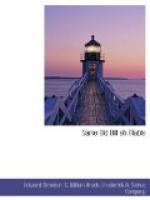A much longer specimen of the Metrical English Psalter will be found in Specimens of Early English, ed. Morris and Skeat, Part II, pp. 23-34, and is easily accessible. In the same volume, the Specimens numbered VII, VIII, X, XI, and XVI are also in Northumbrian, and can easily be examined. It will therefore suffice to give a very brief account of each.
VII. Cursor Mundi, or Cursor o Werld, i.e. Over-runner of the World; so called because it rehearses a great part of the world’s history, from the creation onwards. It is a poem of portentous length, extending to 29,655 lines, and recounts many of the events found in the Old and New Testaments, with the addition of legends from many other sources, one of them, for example, being the Historia Scholastica of Peter Comestor. Dr Murray thinks it may have been written in the neighbourhood of Durham. The specimen given (pp. 69-82) corresponds to lines 11373-11796.
VIII. Sunday Homilies in Verse; about 1330. The extracts are taken from English Metrical Homilies, edited by J. Small (Edinburgh, 1862) from a MS. in Edinburgh. The Northern dialect is well marked, but I do not know to what locality to assign it.
X. Richard Rolle, of Hampole, near Doncaster, wrote a poem called The Prick of Conscience, about 1340. It extends to 9624 lines, and was edited by Dr Morris for the Philological Society in 1863. The Preface to this edition is of especial value, as it carefully describes the characteristics of Northumbrian, and practically laid the foundation of our knowledge of the old dialects as exhibited in MSS. Lists are given of orthographical differences between the Northern dialect and others, and an analysis is added giving the grammatical details which determine its Northern character. Much of this information is repeated in the Introduction to the Specimens of English, Part II, pp. xviii-xxxviii.
XI. The Poems of Laurence Minot belong to the middle of the fourteenth century. He composed eleven poems in celebration of events that occurred between the years 1333 and 1352. They were first printed by Ritson in 1795; and subsequently by T. Wright, in his Political Poems and Songs (London, 1859); and are now very accessible in the excellent and cheap (second) edition by Joseph Hall (Oxford University Press). There is also a German edition by Dr Wilhelm Scholle. The poet seems to have been connected with Yorkshire, and the dialect is not purely Northern, as it shows a slight admixture of Midland forms.
XVI. The Bruce; by John Barbour; partly written in 1375. It has been frequently printed, viz. in 1616, 1620, 1670, 1672, 1715, 1737, and 1758; and was edited by Pinkerton in 1790, by Jamieson in 1820, and by Cosmo Innes in 1866; also by myself (for the Early English Text Society) in 1870-89; and again (for the Scottish Text Society) in 1893-5. Unfortunately, the two extant MSS. were both written out about a century after the date of composition. Nevertheless, we have the text of more than 260 lines as it existed in 1440, as this portion was quoted by Andro of Wyntown, in his Cronykil of Scotland, written at that date. I quote some lines from this portion, taken from The Bruce, Book i, 37-56, 91-110; with a few explanations in the footnotes.




